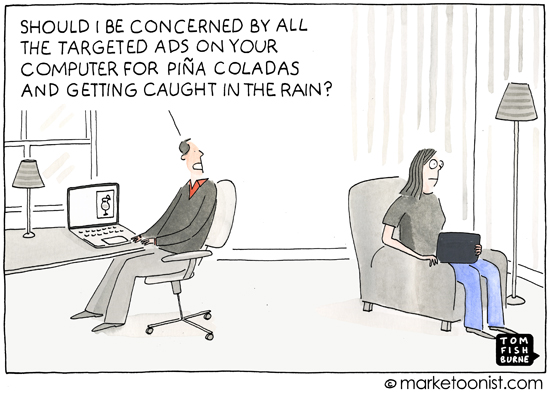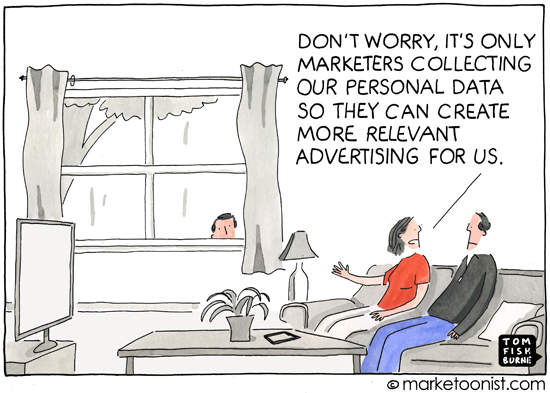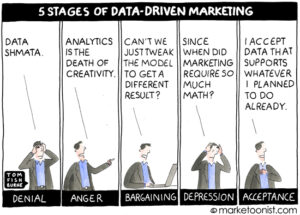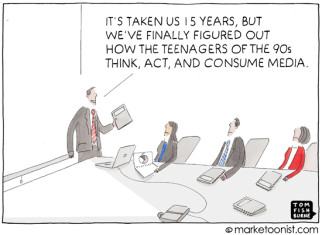Marketers spend a lot of time and effort trying to infer consumer behavior through the signals they leave online and offline.
We’re in an interesting stage here. In some ways, the tools are continually getting more sophisticated (and creepy in their accuracy). In other ways, they are a blunt instrument with a lot of potential to draw false conclusions. Or at the very least, an incomplete picture. The cookie, which has long been the mainstay of tracking consumer activity online, is crumbling, as consumers increasingly live in a multichannel world with screens that don’t talk to each other.
The goal for marketers is to develop more relevant advertising that performs better. There will continue to be a lot of innovation in this space as marketers think beyond the cookie to integrated (yet potentially intrusive) measurement tools. Ads will increasingly be based, not just on retargeting consumers that have already visited certain sites, but on a composite based on a huge range of online and offline signals, and inferring what those signals mean to predict consumer behavior.
And then, of course, there’s how consumers will react to an advertising world that tries to predict their needs and wants in an increasingly personal way. Will consumers see this future as utopian or dystopian?
Here’s a a cartoon I drew a couple years ago on this dynamic.
My post included a telling quote from Macy’s VP of customer strategy, Julie Bernard, that captures this dilemma:
“Consumers are worried about our use of data, but they’re pissed if I don’t deliver relevance… How am I supposed to deliver relevance and magically deliver what they want if I don’t look at the data?”
I’d love to hear your thoughts on how marketers should work through this dilemma.
(Marketoonist Monday: I’m giving away a signed cartoon print. Just share an insightful comment to this week’s post by 5:00 PST on Monday. Thanks!)




Nick Salyers says
Data is an exciting and scary thing. And we do expect a lot from marketers, we want them to deliver AND respect our privacy. It will be an interesting time to see how the public collectively embraces new strategies or fights them. I fear that some marketers will take it too far and ruin it for the rest. Soon I believe there will be legislations on what data you can collect and what you can’t or at least legislation blocking certain kinds of data collection. Could create a black market for data which would be fascinating actually (maybe make for a good cartoon!). Here’s hoping that we can be creative with data and use it well to deliver, and find that balance between relevancy and privacy, before it is too late. Thanks for the entertaining post! -Nick
DMC says
I think the problem is it’s evolved as an adversarial dynamic. In reality it’s a symbiotic relationship, but customers feel like a commodity instead of as consenting partners. They do want that relevancy, and they know they benefit from it, but the data required to build those bridges is often gleaned surreptitiously; people ultimately feel used and lied to, or like they’ve had something stolen from them. I think if consumers were offered more transparency and were afforded the opportunity to make educated choices, less energy would need to be spent devising ways to extract information from people who are increasingly wary and resentful.
Stef Elliott says
Very valid point Nick
Controversial question maybe but are some technology providers helping some Marketers capture data on unsuspecting consumers?
I don’t know the situation in the US but here in Europe the rapid development and expansion of new technology platforms means that the law is “lagging” what is possible and so the actual requirements to meet specific standards i.e.
• Best practice
• Common practice – Industry standards
• Accepted practice – Consumers preferences
• Required practice – Legally stated and enforced
have not been clearly defined and are difficult to clarify for marketers.
For example the use of device fingerprinting has recently been highlighted as contravening the law if implemented via the gaining of access to or the storing of information on the user’s terminal device without the valid consent of the user (unless an exemption applies) but is still being actively promoted as “the cookie replacement” and to support multi device identification.
Do consumers really understand how the ads they see are driven by data and how that data is harvested and combined with other data ? In the short term this may not have any negative impact but once the consumers become more aware how will they treat brands that they believe may have abused the trust they have for the brand.
To extend the analogy – How would my wife react if she saw me in a bar called O’Malleys with two glasses of Pina Colada?
Tracy Carlson says
Here’s a radical thought: create advertising that is intrinsically interesting and engaging enough that people will actually want to pay attention–then you don’t have to worry about mining data and/or creeping people out. The best way to do this is bring in the artists. Whether it’s creating continuing story lines that people want to follow, connecting your brand in some imaginative way visually or any number of possibilities, enlisting artists to do some nonlinear creative thinking is more likely to serve up better options than anything a propeller-headed data mining expert will come up with.
Arun Prabhu says
The job of a marketer is to listen to consumers, understand them and their deeper motivations and deliver solutions they need not what they say they want. Consumers accept that we’re looking at their data. That doesn’t mean they want to be blantantly reminded of it. If they’re pissed that we’re not delivering relevance, we’re clearly not doing a good enough job.
Our role is to look at the behaviour, make seemingly irrelevant connections with other pieces of data and analyse to uncover deep level motivations, pain points and currently unmet needs. In other words, the WHY beneath the WHAT. Once we get that, providing a solution that engages our consumer partners rather than pisses them off is releatively easy.
Andy Sampogna says
The role of the marketer is to sell product. Better the product, easier the marketing. Data-driven marketing or at least the right data helps organizations facilitate selling by pin-pointing messages and offers, mostly with the objective of being more efficient with their spend. I think most people know and accept this. One gives, with the hope that they receive something in return. Its the classic loyalty relationship trade-off. Relevancy and privacy is often traded off for free or a really good deal.
Irama Navarro says
When talking about privacy and the use of consumers data something that always comes to my mind in data collection and data analysis is DATA VOLUME. We need large volumes of data to be able to see patterns and behavioural trends, then decide and create appealing messages for different segments. Although data is collected individually and then is presented to the individuals (within a target segment) I think individual data looses that personal value to contribute to the bigger picture and then benefit from it.
Rick Sage says
For me, the post also depicts the veering of two paradigms, consumers’ online vs offline behavior.
The formation of complex and challenging beta tools (digital tracking and measuring tools) currently in play do not bring rise to the level of awareness for how to unify individuals’ discrete units of the human psyche (which stems from various ways of viewing the world, its own perceptions, its own beliefs and rule, and its own specific history). Awesome post; so much more to consider.